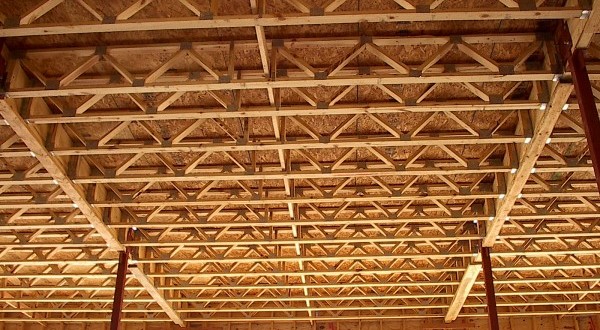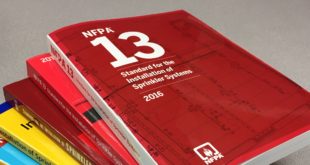Different Construction Materials Create Different Issues
I may be aging myself, but do you remember the days of using the maximum spacing for hangers and the 40, 80 rule? There was no concern that the building structure would not support the sprinkler pipe, and we spaced lateral braces 40 ft on center and longitudinal braces 80 ft on center. Ah, the good old days.
The computer age arrives; drawing boards become a thing of the past and we learn from careful study of actual earthquakes and sophisticated testing that we can improve our methods of hanging and bracing.
Each new code cycle of NFPA 13, Standard for the Installation of Sprinkler Systems, Chapter 9, reflects the results of these findings. By applying these codes when designing the hangers and braces, the protection of sprinkler systems from damage during a seismic event will continue the excellent track record of protecting property and saving lives.
So why would a sprinkler layout technician/designer encounter chal- lenges when all of this information can be found in NFPA 13 Chapter 9?
Over the last few years the method of designing buildings and structures has been done utilizing computer programs and models, which allow the architects and structural engineers to design a more efficient, leaner and less expensive product for the end user and owner. Many new materials that go under the heading of lightweight construction are being used. Most buildings are being developed using Building Information Modeling (BIM). This allows the design team to produce a three dimensional living model of the building before construction begins. By having all of this information, the structure can be designed without estimating the unknown and, therefore, the lightest least-expensive structural members can be used.
The challenges when hanging and bracing to lightweight construction occur in concrete, wood and steel alike.
An important thing to remember, which many structural engineers are not aware of, can be found in NFPA 13, 2013 edition, Section 9.2.1.3.1.
“The building structure must support the added load of the water-filled pipe plus a minimum of 250 lbs applied at the point of hanging.”
Wood Construction
Typical lightweight wood structural members are open web joists and composite wood joists. Most of the manufacturers of these joists have addressed the hanging and bracing issues. They provide methods of attaching and bracing, indicating the maximum loads that can be safely applied.
Steel Joist Construction
In previous editions of Sprinkler Age magazine, open web steel joist has been addressed. The Steel Joist Institute (SJI) has published articles stating that the maximum load (concentric) that can be applied to the joist is 100 lbs. Any load in excess should be applied at the panel point or additional stiffeners must be added.
Knowing this, we can see that all sprinkler pipe hangers must be at the panel points because of the NFPA safety factor of 250 lbs. The word “concentric” is telling the designer not to apply this load to the side of the joist, for example using a C clamp to the side. The load must be applied to the center of the joist. Bracing to this type of joist should always be submit- ted to the structural engineer of record indicating the method of attachment and load being applied.
Concrete
This construction material has become a hanging and bracing challenge. All types, including flat slab poured in place, post tension and lightweight concrete filled metal decking, need to be carefully assessed when designing hangers and braces.
The Technical Committee for Chapter 9 of NFPA 13, 2016 edition has spent many hours reviewing the maximum loads for post-installed concrete anchors.
The tables shown in NFPA 13, 2013 edition, Figure 9.3.5.12.1 will not be recognizable in the new 2016 edition. The maximum loads will be substantially lower. This was done so that the NFPA 13 code would not lose its cross reference as an equivalent guideline to ASCE 7 for providing seismic protection for fire sprinkler systems.
Standard lightweight concrete as shown in NFPA 13 is 3000 psi. The maximum brace loads for cracked concrete and concrete filled metal decking can be found in Figure 9.3.5.12.1. Increasing the angle of the brace from vertical can substantially increase the maximum load, therefore increasing the spacing between braces. In new construction projects it may be cost effective to consider using preapproved concrete inserts. There are many manufacturers of these inserts that will provide details showing the maximum loads. In many cases these loads can be greater than post-installed concrete anchors, therefore reducing the quantity of braces required. The sprinkler layout technician/designer should review Section 9.1.3 “Fasteners into Concrete” when designing hangers and braces.
One of the most challenging types of lightweight construction materials is insulated concrete-filled metal decking. This material is not designed to support large hanging loads.
In most cases the structural engineer of record will limit the load that can be applied from the metal deck flutes. A typical maximum load on recent projects that I have worked on is 100 lbs per flute for hanging and no bracing allowed at all. Before considering the weight of water-filled pipe that you are trying to support, the hanger would be required to span three flutes just to satisfy the 250 lb NFPA 13 safety factor. This becomes a hanging problem for even small lengths of sprinkler pipe.
The following is an example of how lightweight structure challenges the designer:
We have a 1-in. x 1-ft 6-in. Schedule 40 armover from a branch line that supplies a 1-in. x 1-ft 6-in. Schedule 40 drop to a sprinkler in a suspended ceiling. The maximum pressure at that sprinkler exceeds 100 psi. Per NFPA 13, 2013 Section 9.2.3.5.2 the armover will require a hanger. The total load at the point of attachment forthathangerwillbe1in.x3ft0 in. of Schedule 40 water-filled pipe plus 250 lbs safety factor. The weight of 1-in. Schedule 40 water-filled pipe is 2.05 lbs per feet; therefore, the total load is 256 lbs.
The hanger would be required to span three flutes with a maximum load of 100 lbs per flute.
Would this hanger now be considered a “trapeze”? Following Table 9.1.1.7.1(a) with the shortest span of 1.5 ft, the sectional modulus would be 0.08 which would require a piece of 11⁄2-in. x 11⁄2-in. x 3/16-in. angle iron with an attachment from each of the three flutes.
As can be seen from the above example, a review of the building structure prior to designing a sprinkler layout is of paramount importance to avoid costly hangers and braces.
ABOUT THE AUTHOR: Ray Lambert is currently the design manager for Western Fire Protection, Poway, California. He began his career in Manchester, England for Mather and Platt at the age of 16, and immigrated to California in 1982. Lambert has over 40 years’ experience in fire protection design. He was recently involved in the UCSD Earthquake Research Project in San Diego and is an alternate member of NFPA 13 Hanging and Bracing Committee.
MPORTANT NOTICE: As a member of the NFPA 13 Hanging and Bracing Committee, the following disclaimer applies. The article and its content is not a Formal Interpretation issued pursuant to NFPA regulations. Any opinion expressed is the personal opinion of the author and presenter and does not nec- essarily represent the official position of the NFPA and its technical committee.
 Sprinkler Age A Publication of the American Fire Sprinkler Association
Sprinkler Age A Publication of the American Fire Sprinkler Association

